The Solar-Powered UAV Market is estimated to be valued at USD 389.1 million in 2025 and is projected to reach USD 938.1 million by 2035, registering a compound annual growth rate (CAGR) of 9.2% over the forecast period. The market shows a steady increase over the forecast period, driven by advancements in renewable energy and UAV technologies. Between 2025 and 2027, the market sees consistent growth, with share gains attributed to the increasing adoption of solar-powered UAVs in surveillance, agriculture, and environmental monitoring.
During this period, the market expands from USD 389.1 million to USD 424.9 million, driven by technological advancements and cost reductions in solar cells, which enhance the performance and efficiency of UAVs. From 2027 to 2030, the market enters a more rapid growth phase, reaching USD 506.6 million by 2030. The share gains during this phase are driven by significant increases in defense and commercial applications, with solar-powered UAVs gaining traction in long-duration surveillance and data collection missions, where traditional battery power is inadequate. Between 2030 and 2035, the market continues to expand at a steady pace, reaching USD 938.1 million. The share gains are primarily driven by increasing demand for eco-friendly solutions and cost-effective UAVs in industries such as logistics, telecommunications, and disaster management. The market does not experience significant erosion but rather a consistent upward trajectory with growing competition and adoption.
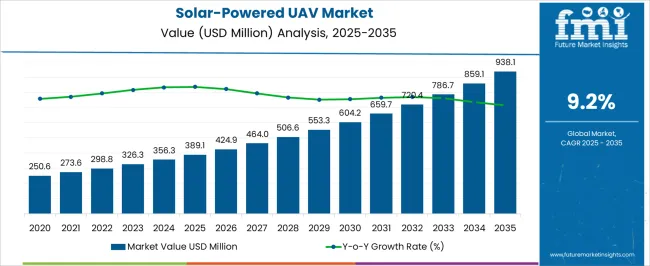
| Metric | Value |
|---|---|
| Solar-Powered UAV Market Estimated Value in (2025 E) | USD 389.1 million |
| Solar-Powered UAV Market Forecast Value in (2035 F) | USD 938.1 million |
| Forecast CAGR (2025 to 2035) | 9.2% |
The solar-powered UAV market is gaining substantial traction due to the growing demand for long-endurance and energy-efficient aerial platforms in defense, environmental monitoring, and communication relay applications. These UAVs are uniquely positioned to address operational challenges in remote or inaccessible regions, owing to their ability to remain airborne for extended periods using renewable solar energy.
Technological advancements in lightweight composite materials, photovoltaic efficiency, and autonomous flight control systems have further expanded the viability of solar-powered drones for both tactical and strategic missions. Increasing investments from defense agencies and aerospace innovators are driving prototype development and deployment of high-altitude long-endurance (HALE) systems.
Additionally, global focus on sustainability and carbon-neutral operations has aligned with the strategic push for greener aviation solutions, supporting further R&D funding As solar-powered UAVs evolve into platforms capable of carrying advanced payloads such as surveillance systems, atmospheric sensors, and communication modules, their adoption is projected to increase significantly across defense, commercial, and environmental domains in the coming years.
The solar-powered UAV market is segmented by mode of operation, type, range, end-user, and geographic regions. By mode of operation, solar-powered UAV market is divided into Autonomous and Semi-autonomous. In terms of type, solar-powered UAV market is classified into Fixed wing drones, Multirotor drones, and Hybrid. Based on range, solar-powered UAV market is segmented into More Than 300 KM and Less Than 300 KM. By end-user, solar-powered UAV market is segmented into Government & Defense, Commercial, Agricultural, and Others. Regionally, the solar-powered UAV industry is classified into North America, Latin America, Western Europe, Eastern Europe, Balkan & Baltic Countries, Russia & Belarus, Central Asia, East Asia, South Asia & Pacific, and the Middle East & Africa.
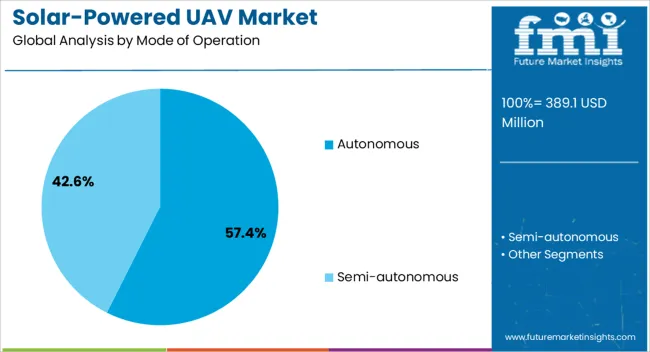
The autonomous segment is expected to contribute 57.4% of the total revenue in the solar-powered UAV market in 2025, reflecting its leading position in terms of operational preference. This dominance is being driven by the strategic necessity for UAVs that can perform prolonged missions with minimal human intervention. Autonomous capabilities have enabled efficient energy usage and optimal altitude maintenance, particularly important for solar-powered platforms that rely on continuous sunlight exposure.
Integration of advanced GPS navigation, real-time decision-making algorithms, and onboard AI modules has enhanced mission reliability and responsiveness under diverse environmental conditions. The ability to automatically adjust flight paths, manage payload functions, and execute return-to-base protocols without manual control has become crucial in high-altitude operations.
Moreover, autonomous flight functionality aligns with defense requirements for covert intelligence missions and border patrol, where human control may not be feasible With consistent advancements in sensor fusion and onboard processing, autonomous UAVs are anticipated to remain the cornerstone of solar-powered aerial operations.
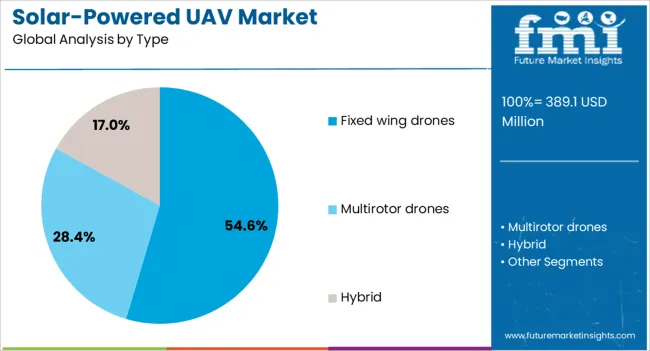
Fixed wing drones are projected to represent 54.6% of the overall market share in the solar-powered UAV market by 2025, owing to their aerodynamic efficiency and extended flight range. This segment has gained prominence due to its suitability for high-altitude, long-endurance missions, which are essential in surveillance, atmospheric research, and communication relay. Fixed wing configurations allow greater surface area for solar panel integration, thereby enhancing energy harvesting and flight sustainability.
The reduced drag and optimized lift-to-weight ratio in fixed wing UAVs have contributed to increased payload capacity and higher operational ceilings. Their mechanical simplicity and lower energy consumption make them preferable for missions requiring days or even weeks of uninterrupted flight.
Furthermore, integration of composite materials and lightweight designs has enabled fixed wing drones to achieve superior energy-to-weight ratios, further improving solar energy utilization As governments and enterprises seek to expand persistent aerial capabilities without reliance on traditional fuel sources, fixed wing drones continue to lead in deployment and investment.
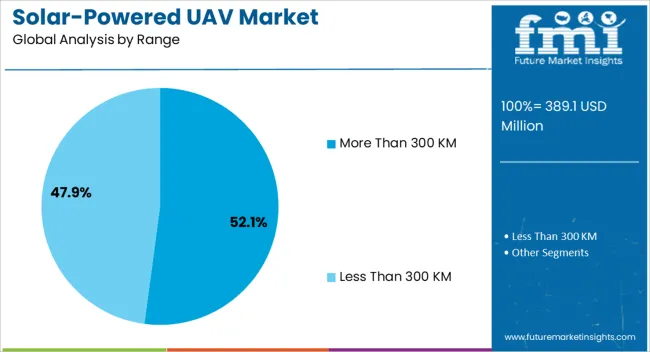
The more than 300 KM range segment is estimated to hold 52.1% of the revenue share in the solar-powered UAV market in 2025, driven by the growing demand for ultra-long-range surveillance and data acquisition missions. This segment’s prominence is being fueled by requirements for cross-border monitoring, large-area mapping, and long-haul communication services that cannot be effectively served by short-range UAVs.
Solar-powered UAVs designed for extended ranges leverage high-efficiency solar modules and energy storage systems to support continuous operations over vast geographical zones. Their ability to fly at high altitudes and operate beyond visual line of sight has made them ideal for environmental observation, maritime surveillance, and communication relays in rural and offshore regions.
Enhanced battery systems and lightweight aerodynamic structures have allowed these UAVs to maintain stability and power balance over long distances As strategic focus intensifies on persistent intelligence gathering and real-time connectivity, UAVs in the more than 300 KM range segment are anticipated to remain critical assets for both government and commercial missions.
The solar-powered UAV market is experiencing significant growth, driven by advancements in renewable energy technologies and the increasing demand for aerial systems. These UAVs utilize solar energy to extend flight durations, making them ideal for applications in surveillance, environmental monitoring, and telecommunications. Innovations in lightweight solar panels and energy management systems have improved their performance, allowing for long-endurance flights without the need for traditional fuel. As industries continue to seek eco-friendly alternatives and governments invest in renewable energy infrastructure, the adoption of solar-powered UAVs is expected to increase, further boosting market growth in the coming years.
Innovations in photovoltaic materials and energy storage systems have enhanced the efficiency and power-to-weight ratio of solar panels, making them more suitable for UAV applications. Environmental concerns are another major driver, as the demand for reducing carbon footprints and minimizing environmental impact increases, making solar-powered UAVs an attractive alternative to fuel-powered drones. The military and defense sectors also contribute significantly to the market, as the need for long-endurance surveillance and reconnaissance missions drives the development of solar-powered UAVs. Industries such as agriculture, infrastructure inspection, and telecommunications are leveraging solar-powered UAVs for tasks like crop monitoring, asset inspection, and network maintenance, further expanding the market’s reach.
One of the main obstacles is the limitation in energy efficiency, as current solar panel technologies may not generate enough power to keep UAVs operational during extended periods without sunlight or in adverse weather conditions. The high development costs associated with integrating advanced solar technologies and lightweight materials also pose a challenge, making these UAVs more expensive than traditional models. Regulatory hurdles are another concern, as obtaining the necessary certifications and adhering to airspace regulations can be complex and time-consuming. Ensuring seamless integration of solar power systems with existing UAV platforms requires specialized engineering expertise, further complicating the development process.
The solar-powered UAV market presents numerous opportunities for growth and innovation. The development of hybrid power systems, which combine solar energy with battery storage, is one such opportunity. These systems can offer enhanced operational flexibility, allowing UAVs to operate in a wider range of conditions. Emerging markets with abundant sunlight and growing infrastructure needs present new avenues for deploying solar-powered UAVs, particularly in regions like Asia-Pacific and Latin America. Collaborations between renewable energy providers and technology firms can also accelerate innovation and reduce the costs associated with solar-powered UAVs, enabling more widespread adoption. The customizing solar-powered UAVs to meet the unique requirements of various industries, such as defense, telecommunications, and agriculture, can open up niche markets and applications, further driving market growth.
The miniaturization of components is driving the demand for smaller, more efficient UAVs capable of longer flights. As component designs become more compact and energy-efficient, UAVs can operate for extended periods without additional power sources. The integration of artificial intelligence (AI) for autonomous navigation and decision-making is enhancing the capabilities of solar-powered UAVs, enabling them to perform complex tasks without human intervention. Additionally, advancements in materials and construction techniques are improving the durability and reliability of these UAVs, allowing them to withstand harsh environments. Furthermore, equipping UAVs with advanced sensors and data processing systems allows for real-time data analysis and decision-making, expanding their use in fields such as environmental monitoring, agriculture, and telecommunications. These trends indicate a dynamic market, with continuous advancements that will drive the adoption and capabilities of solar-powered UAVs in various industries.
| Country | CAGR |
|---|---|
| China | 12.4% |
| India | 11.5% |
| Germany | 10.6% |
| France | 9.7% |
| UK | 8.7% |
| USA | 7.8% |
| Brazil | 6.9% |
The global solar-powered UAV market is projected to grow at a CAGR of 9.2% from 2025 to 2035. Among the key markets, China leads with a growth rate of 12.4%, followed by India at 11.5%, and France at 9.7%. The United Kingdom and the United States show more moderate growth rates of 8.7% and 7.8%, respectively. Emerging markets like China and India are experiencing faster growth due to their expanding aerospace and renewable energy sectors, while developed markets such as the USA and the UK show steady demand driven by advancements in high-tech industries and government initiatives for clean technologies. The analysis spans over 40+ countries, with the leading markets shown below.
China is expected to lead the global solar-powered UAV market, growing at a projected CAGR of 12.4% from 2025 to 2035. The country’s rapid development in aerospace and drone technology, along with increasing investments in solar-powered UAV applications for surveillance, agriculture, and disaster management, is fueling market demand. The growing adoption of UAVs for environmental monitoring and agricultural applications is expected to play a significant role in China’s market growth. Government initiatives to support the development of eco-friendly and energy-efficient technologies, such as solar-powered UAVs, will further boost market expansion.
Demand for solar-powered UAV in India is expected to experience strong growth, projected to expand at a CAGR of 11.5% from 2025 to 2035. The increasing need for energy-efficient drones in agricultural monitoring, disaster management, and surveillance is driving the demand for solar-powered UAVs. India’s rapidly growing interest in drone technology, along with its expanding solar energy sector, is contributing to the adoption of UAVs that leverage solar power for longer flight durations. The government’s push to use drones in sectors such as defense, agriculture, and infrastructure monitoring is also expected to support the market’s growth.
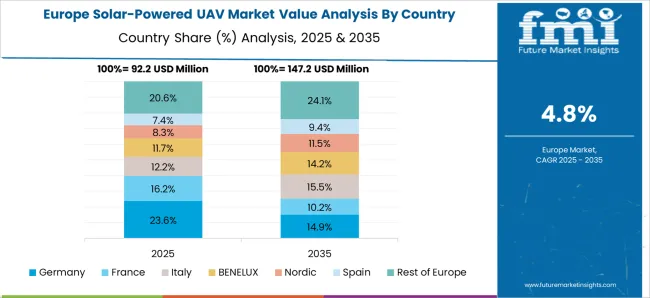
Sale of solar-powered UAV in France is projected to grow at a steady pace, with a CAGR of 9.7% from 2025 to 2035. The country’s significant investments in defense, surveillance, and environmental monitoring sectors are driving demand for solar-powered UAVs. France’s focus on sustainability and green technologies is a major factor influencing the adoption of solar-powered UAVs in various industries. Furthermore, the use of UAVs for precision agriculture, infrastructure inspections, and environmental conservation is expected to play a key role in expanding the market. As France continues to innovate in aerospace and renewable energy sectors, solar-powered UAVs will likely find increasing application in both commercial and governmental sectors.
The United Kingdom’s solar-powered UAV market is expected to grow at a CAGR of 8.7% from 2025 to 2035. The rise of renewable energy technologies and growing interest in sustainable drone solutions are driving demand for solar-powered UAVs in the UK The country’s commitment to reducing carbon emissions and advancing clean technologies is influencing the growing adoption of solar-powered UAVs, especially in industries such as agriculture, surveillance, and defense. The use of UAVs for infrastructure monitoring and environmental surveys is contributing to the market’s growth. As the UK continues to integrate advanced drone technologies and green solutions, the market for solar-powered UAVs is expected to expand steadily.
The solar-powered UAV market in the United States is projected to grow at a CAGR of 7.8% from 2025 to 2035. The country’s strong presence in aerospace innovation, coupled with its expanding defense, agriculture, and environmental monitoring sectors, is driving the demand for solar-powered UAVs. The USA is increasingly adopting solar-powered UAVs for military surveillance, agricultural monitoring, and environmental data collection. The rise of drone applications in renewable energy monitoring, coupled with government support for clean technology, further accelerates the adoption of solar-powered UAVs. As technological advancements continue, the USA solar-powered UAV market is expected to grow steadily, supported by rising applications across various industries.
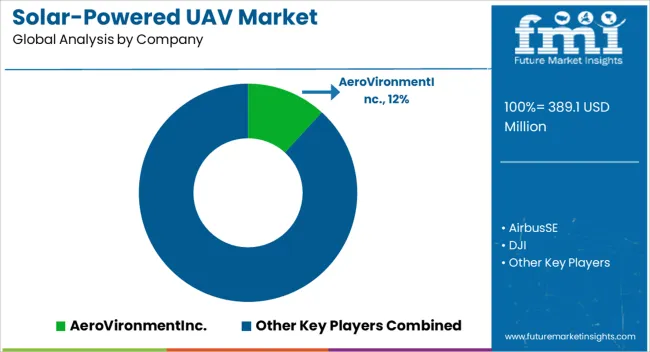
The solar-powered UAV market is witnessing significant growth, driven by innovations in renewable energy and autonomous flight technologies. AeroVironment Inc. leads the market with its advanced UAV solutions, focusing on long endurance and high-altitude capabilities for military and commercial applications. Airbus SE brings cutting-edge solar-powered UAV technology, integrating sustainable energy sources with aerospace systems to enhance the functionality of unmanned aerial systems. DJI is a major player in the drone market, expanding its product range with solar-powered UAVs for surveying, environmental monitoring, and other commercial applications.
BAE Systems is focused on developing advanced solar-powered UAVs for defense and intelligence purposes, with an emphasis on surveillance and reconnaissance. Aurora Flight Sciences, a subsidiary of Boeing, is known for its innovative designs in solar-powered UAVs, pushing the boundaries of autonomous flight and endurance. The Chinese Academy of Aerospace Aerodynamics plays a significant role in developing solar UAV technologies, leading efforts in China with a focus on high-altitude, long-duration flights.
Skydweller Aero is at the forefront of developing solar-powered UAVs for long-duration flight, aimed at providing sustainable aerial systems for various industries, including telecommunications and environmental monitoring. Silent Falcon UAS Technologies is renowned for its lightweight and eco-friendly UAV solutions, offering solar-powered UAVs for reconnaissance missions. Atlantik Solar, QinetiQ, and Kea Aerospace are advancing solar UAV technology with a focus on enhancing endurance and range for both commercial and defense applications.
Other notable players like Elektra, Sunbirds SAS, Xsun, Avy, Eos Technologie, UAV-instruments, and Korea Aerospace Research Institute continue to push the limits of solar-powered UAV capabilities, focusing on sustainable solutions for surveillance, precision agriculture, and environmental monitoring.
| Item | Value |
|---|---|
| Quantitative Units | USD 389.1 Million |
| Mode of Operation | Autonomous and Semi-autonomous |
| Type | Fixed wing drones, Multirotor drones, and Hybrid |
| Range | More Than 300 KM and Less Than 300 KM |
| End-user | Government & Defense, Commercial, Agricultural, and Others |
| Regions Covered | North America, Europe, Asia-Pacific, Latin America, Middle East & Africa |
| Country Covered | United States, Canada, Germany, France, United Kingdom, China, Japan, India, Brazil, South Africa |
| Key Companies Profiled | AeroVironmentInc., AirbusSE, DJI, BAESystems, AuroraFlightSciences, ChineseAcademyofAerospaceAerodynamics, SkydwellerAero, SilentFalconUASTechnologies, AtlantikSolar, QinetiQ, KeaAerospace, Elektra, SunbirdsSAS, Xsun, Avy, EosTechnologie, Uav-instruments, and KoreaAerospaceResearchInstitute |
| Additional Attributes | Dollar sales by product type (fixed-wing solar UAVs, hybrid solar UAVs, rotary-wing solar UAVs) and end-use segments (defense, telecommunications, agriculture, environmental monitoring, logistics). Demand dynamics are driven by the growing need for sustainable, long-endurance UAVs, increased use in surveillance, data collection, and environmental applications. Regional trends show strong growth in North America, Europe, and Asia-Pacific, fueled by advancements in solar technology, regulatory support for green aviation, and increased adoption of UAVs in various sectors. |
The global solar-powered UAV market is estimated to be valued at USD 389.1 million in 2025.
The market size for the solar-powered UAV market is projected to reach USD 938.1 million by 2035.
The solar-powered UAV market is expected to grow at a 9.2% CAGR between 2025 and 2035.
The key product types in solar-powered UAV market are autonomous and semi-autonomous.
In terms of type, fixed wing drones segment to command 54.6% share in the solar-powered UAV market in 2025.






Full Research Suite comprises of:
Market outlook & trends analysis
Interviews & case studies
Strategic recommendations
Vendor profiles & capabilities analysis
5-year forecasts
8 regions and 60+ country-level data splits
Market segment data splits
12 months of continuous data updates
DELIVERED AS:
PDF EXCEL ONLINE
UAV Satellite Communication Market Size and Share Forecast Outlook 2025 to 2035
Guava Puree Market Size and Share Forecast Outlook 2025 to 2035
Fuel Cell UAV Market Size and Share Forecast Outlook 2025 to 2035
Unmanned Aerial Vehicles (UAV) Commercial Drone Market Size and Share Forecast Outlook 2025 to 2035

Thank you!
You will receive an email from our Business Development Manager. Please be sure to check your SPAM/JUNK folder too.
Chat With
MaRIA